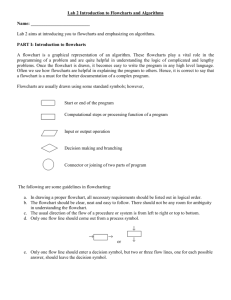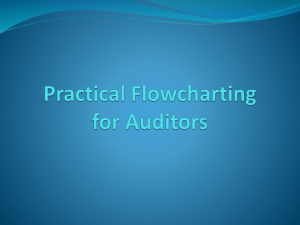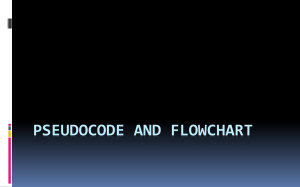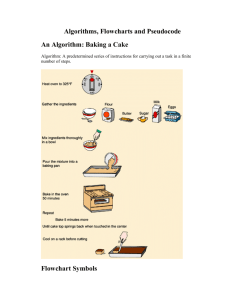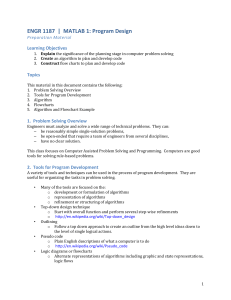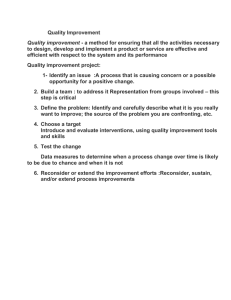Sample
advertisement
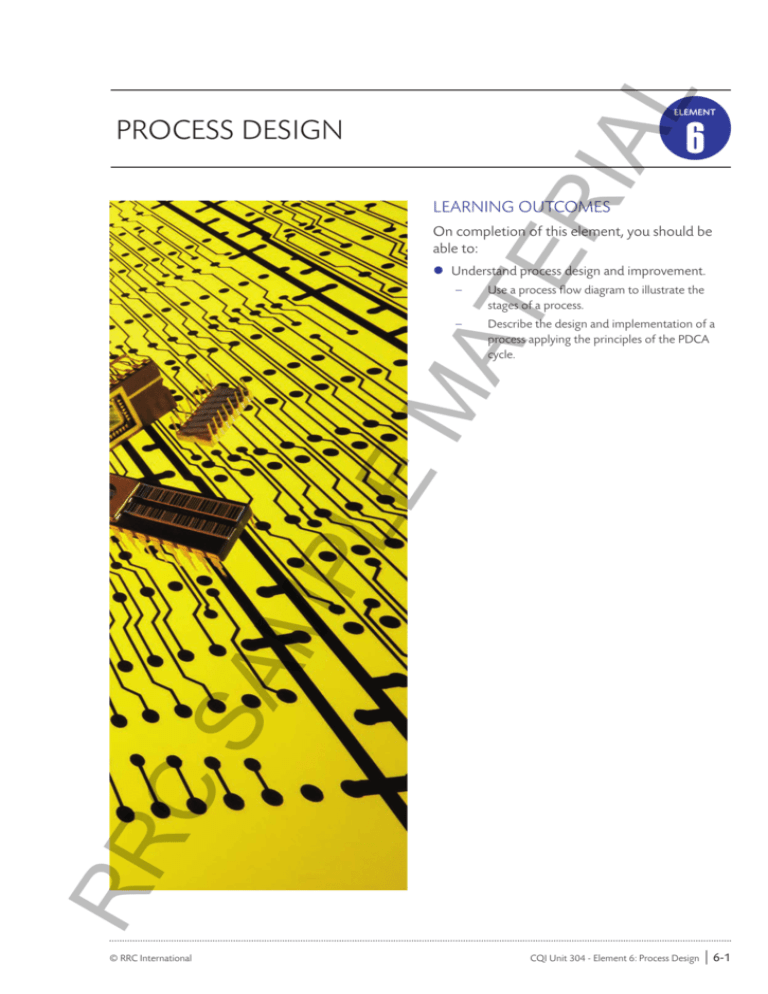
IA L ELEMENT 6 TE R PROCESS DESIGN LEARNING OUTCOMES On completion of this element, you should be able to: zz Understand process design and improvement. Use a process flow diagram to illustrate the –– stages of a process. Describe the design and implementation of a process applying the principles of the PDCA cycle. RR C SA MP L E MA –– © RRC International CQI Unit 304 - Element 6: Process Design | 6-1 IA L Contents PROCESS DESIGN AND PROCESS FLOW DIAGRAMS Process Design within an Organisation Porter’s Value Chain Process Mapping Revision Questions 6-3 6-3 6-5 6-6 6-12 TE R PROCESS DESIGN AND THE PDCA CYCLE Process Design Scenario Revision Questions 6-13 6-13 6-15 RR C SA MP L E MA SUMMARY6-16 6-2 | CQI Unit 304 - Element 6: Process Design © RRC International KEY INFORMATION IA L Process Design and Process Flow Diagrams • Process design is all about determining and organising the tasks required in executing a business process. • In macro terms, there are three basic types of business process: –– Management. TE R –– Primary (or operational). –– Secondary (or supporting processes). • Michael Porter developed his value-chain model as a simplistic way for businesses to strategically examine their macro business processes. • Process mapping is used to provide an easy-to-follow picture of business micro processes by identifying all the steps and decisions involved in a process. –– Flowcharts. –– Deployment charts. MA • The output from a process-mapping activity can take on many formats, but the two types of application commonly used are: In general terms, process design can be viewed as the design of all the activities that are necessary to achieve the successful transformation of materials, information, labour, etc. into outputs such as products, services, reports, etc. MP L E Process design is an activity that can be performed at either macro (functional) or, more commonly, micro (operational) levels. We will consider both of these but our main focus will be on micro process design. PROCESS DESIGN WITHIN AN ORGANISATION In simple terms, the activity of process design is all about determining and organising the tasks required in executing a business process. SA Typically, the task of process design will use a number of different tools and techniques. One of the most common of those used for process design (or process evaluation) is process flow diagrams. The Process Concept RR C In the preceding elements of this unit we have discussed the concept of viewing business transformation activities as a process. The diagram below is a simplified reminder of this process. © RRC International CQI Unit 304 - Element 6: Process Design | 6-3 MA TE R IA L Process Design and Process Flow Diagrams E The business transformation process SA MP L In practice, most businesses consist of multiple processes interconnected in a value chain, this chain concluding with the supply of goods and services to the end customer. As such, the output of one process becomes the input to the next process, as illustrated in the following diagram. The business value chain RR C This means that the ‘process owners’ along this value chain can be perceived as both internal customers and suppliers in the day-to-day activity of the business. The ‘flow’ of value-adding activities can be visually mapped using a technique referred to as ‘process mapping’ or ‘process flowcharting’. This will be covered in more detail later in this element. 6-4 | CQI Unit 304 - Element 6: Process Design Types of Business Process In general terms, we can define three basic types of business process: • Management processes, e.g. strategic management. • Primary (or operational) processes - those that constitute the core business and create the primary value stream, e.g. production. • Secondary (or supporting processes), e.g. IT. © RRC International Process Design and Process Flow Diagrams MA When designing business processes, the following key points should be borne in mind: • Such processes are designed to add value for the customer and therefore should not include unnecessary activities. • The outcome of a well-designed business process is: –– Increased effectiveness, i.e. value for the customer. TE R We can view business processes in both a macro and a micro format. For example, we can view the process of the Purchasing Department in overall terms or we can break down the purchasing activity into micro or sub-processes, which have their own attributes, but also contribute to achieving the goal of the Purchasing Department. IA L All the above process types are necessary for the successful provision of products and services. As such, the words ‘primary’ and ‘secondary’ should not be interpreted as one type of process being more important than the other. For example, could a business function survive without the support of the IT Department? –– Increased efficiency, i.e. less costs for the business. PORTER’S VALUE CHAIN RR C SA MP L E Michael Porter, a management guru, developed his value-chain model as a simplistic way for businesses to strategically examine their macro business processes, these being categorised into primary (core) processes and secondary (support) processes – see the diagram which follows. © RRC International Porter’s value-chain model CQI Unit 304 - Element 6: Process Design | 6-5 The model represents a value chain of activities with the products and services passing through all the primary activities of the chain in order, gaining some added value from each activity. Importantly, the chain of primary activities should give the products and services more added value than the sum of added values of all activities. In other words, the objective should be that the outcome of these activities is to offer the customer a level of value that exceeds the cost of the activities, thus resulting in a profit margin. PROCESS MAPPING IA L Process Design and Process Flow Diagrams Whereas Porter’s value chain created a macro picture of business processes, process mapping focuses on developing a micro picture of operational activities. It is a technique for producing a visual representation of any process activity. • Operations. • Eliminating unnecessary (or wasteful) tasks. • Outbound Logistics. • Clarifying roles within the process. • Marketing and Sales. • Reducing delays and duplication – particularly where there are multiple processes involved. • Service. • Business Infrastructure. • Human Resource Management. • Technology. • Agreeing common processes. In visual terms, a process map identifies all the steps and decisions involved in a process. It: • Describes the flow of materials, information and documents. E The secondary, or support, activities are the areas of the organisation which are required to allow the organisation to function, but do not always add value to the product or service: MA Within Porter’s model we have the primary or core business activities that primarily add value to the product or service: TE R • Inbound Logistics. The initial task of process design, or process re-evaluation, is to define the sequence of activities that are to be undertaken during the transformation process that converts inputs to outputs. The technique of process mapping is the most commonly used technique to provide an easy-to-follow picture of the process in question. This process picture is particularly useful in assisting the design of efficient transformation processes by, for example: • Displays the various tasks contained within the process. • Shows that the tasks transform inputs into outputs. • Indicates the decision points within the overall process activity. MP L • Procurement. Typical examples of support processes include: • Accounting. • Recruitment. • Technical support. SA This macro approach to representing business processes is particularly useful for strategically reviewing the business operation. For example, if the operating profit of a business is under pressure, the business may decide to focus on what it does best and, as a consequence, outsource the IT support activity, if this would be cost-effective. The output from a process-mapping activity can take on many formats, but there are two types of application commonly used: • Flowcharts – these provide a picture of all the activities undertaken for the process(es) being investigated. • Deployment charts – also provide a basic process overview, but in addition indicate where or by whom the actions are performed. Here we will focus predominantly on producing flowcharts, but deployment charts are also illustrated for information purposes. RR C More commonly, the review of processes at the micro level is undertaken when designing and re-evaluating process activities. The technique most commonly used for micro process analysis is process mapping. • Demonstrates the essential interrelationships and interdependence between the process steps, and reminds us that the strength of a chain depends on its weakest link. 6-6 | CQI Unit 304 - Element 6: Process Design © RRC International Process Design and Process Flow Diagrams Producing Flowcharts Flowcharts have many different uses and can be used to describe almost any process or procedure. When a process (or procedure) is relatively complex, a flowchart is often more suitable than a long descriptive piece of text. Many people first come across flowcharts in the form of computer program design tools and many flowcharts use symbols that come directly from the computing area. Flowchart symbols E MA The following diagram illustrates some of the common flowchart symbols. TE R TOPIC FOCUS IA L As an example of a flowchart, let’s look at the chart that would be generated by the simplified task of ‘getting to work’. Using the symbols shown previously, this task can be represented by the following flowchart. Flowchart example: getting to work Key points to note when constructing this flowchart are: MP L Some companies may adopt their own flowcharting symbols and methods for flowcharts. However, most companies will use the standard symbols as defined in the standard BS 4058:1987, ISO 5807:1985 Specification for data processing flowchart symbols, rules and conventions. Alternatively, flowcharting symbols can simply be found in Microsoft Word (or equivalent) under ‘Shapes > Flowchart’. SA Each of the symbols used in a flowchart are linked by arrows to display the process or procedure. Flowchart Examples • The first decision point is to ask the question, ‘Is it raining?’ If it is raining, I will take the car, otherwise I will cycle. • The last symbol is always the termination symbol, which designates the end of the flowchart or process. The flowchart that this process generates is almost as simple as a flowchart can be, but the general principle is the same whether the chart has 5 or 500 symbols. Simple charts are often most efficiently created by drawing by hand, whereas more complex charts may require computer assistance. Using the same logic let us now apply the flowcharting concept to a business process. In this scenario, imagine you are running a virtual Web-based business that sells a range of greetings cards. The next flowchart represents the order-processing activity. RR C It is often quite a complex task to sit down and condense a familiar working procedure into a flowchart. Team working is often an important aspect of creating realistic flowcharts. As with many other techniques, the experience of sitting down to complete a task which requires thinking about everyday procedures often results in those procedures being questioned and possibly improved. The flowchart can help in this improvement, as it graphically displays the task and, the more complex the task, the more complex the chart. When the flowchart is simple, then the process that it represents is simple too. • The first symbol will be the Start. © RRC International CQI Unit 304 - Element 6: Process Design | 6-7 RR C SA MP L E MA TE R IA L Process Design and Process Flow Diagrams 6-8 | CQI Unit 304 - Element 6: Process Design Flowchart illustrating order-processing activity © RRC International

